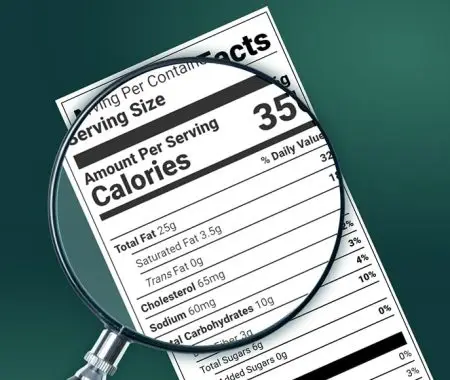For manufacturers in the food and beverage industry, remaining compliant with current regulations in the UK is integral. Front-of-Pack (FoP) labeling is an important factor in compliance and consumer information, as it refers to supplementary nutritional information displayed on the main panel of packaged foods. It is designed to give consumers quick, clear information about the nutritional content of food. While FoP labeling in the UK is voluntary, it plays a significant role in promoting public health by encouraging informed choices and healthier eating habits.
Businesses in the food industry are urged to adopt this labeling to stay competitive and comply with consumer expectations. Nutrition label software offered by companies such as Food Label Maker can also help food manufacturers ensure they remain compliant with UK regulations, making it easier to meet these standards.

TLDR
- FoP Labeling Overview: Voluntary but important for food manufacturers to stay competitive and meet consumer expectations. FoP labels provide quick, clear nutrition information, promoting healthier choices.
- Legal Framework: Based on the UK Food Information Regulations 2014 and retained EU laws, with post-Brexit updates. FoP labels must be accurate, detailed, and not misleading.
- Key Elements:
- Energy (kJ, kcal) and nutrient values for fat, saturates, sugars, and salt.
- Portion sizes and percentage Reference Intakes (RIs) must be displayed.
- Traffic light color-coding (green, amber, red) shows nutrient levels.
- Label Design: Requires clear visibility with specific guidelines for layout, color contrast, and font size to ensure readability.
- Portion Sizes: Must be realistic and consistent between front and back labels.
- Product-Specific Considerations: Different requirements apply to solid foods (100g servings) and beverages (100ml servings). Larger portions may need additional information.
- Post-Brexit Compliance: UK regulations remain aligned with EU standards but have the flexibility to diverge over time. Manufacturers must stay updated on regulatory changes.
- Benefits: FoP labeling aids in transparency and helps consumers make healthier, informed food choices quickly.
Understanding Front-of-Pack (FoP) Food Labeling
Front-of-Pack (FoP) nutrition labelling serves to provide consumers with easily accessible nutritional information, particularly on packaged foods such as pre-prepared meals, convenience foods, and processed products. The intention behind FoP labels is to make nutritional information comprehensive and easy to read, ensuring consumers can make informed decisions quickly.
Though it remains voluntary in the UK, many consumers now expect to see Front-of-Pack labels on these food types. However, certain items, such as those listed in Annex V of the EU Food Information to Consumers (FIC) regulation, are exempt from mandatory labeling.
The legal framework is rooted in the Food Information Regulations 2014 and retained EU laws like EU Regulation (EC) No. 1169/2011. Current standards have changed to adapt to post-Brexit regulations. This ensures consistency with European Commission guidelines and keeps UK businesses aligned with practices across different countries.
See How FoodLabelMaker Can Help You
Key Elements of Front-of-Pack Nutrition Labeling
Front-of-Pack (FoP) nutrition labels are designed to provide clear, easy-to-read information to help consumers make informed choices for a healthy diet. The labels must be:
- Accurate
- Detailed
- Easy to understand
- Not misleading
- Must accompany the mandatory “back-of-pack” nutrition declaration
A well-constructed FoP label will typically include the energy value in kilojoules (kJ) and kilocalories (kcal) per 100g/ml, along with information for a specified portion size. This is often referred to as “energy + 4,” which includes fat, saturates, sugars, and salt. Displaying nutrient information per portion helps consumers understand the nutrition of a realistic serving size, for instance, ¼ of a pie or 1 burger. Labels also frequently include percentage Reference Intake (% RI) data and use color coding to highlight nutrient levels, enhancing visibility and comprehension for healthier food choices.
An FoP nutrition facts label developed per current regulations should depict:
- Key nutrient information such as the energy value in kilojoules (kJ) and kilocalories (kcal) per 100g/ml
- Or
- Kilojoules (kJ) and kilocalories (kcal) plus amounts (in grams) of fat, saturates, sugars and salt
- The % RI information, based on the amount of each nutrient and energy value in a portion of the food
- Information on the portion size, shown in a way that is understandable and easily recognisable by the consumer
- Information on the amounts in grams of fat, saturated fat (“saturates”)2 , (total) sugars and salt in grams, in a specified portion of the product.
- Colour coding of the nutrient content of the food.
Nutrient Information
The “Big 4” nutrients displayed on Front-of-Pack labels, as stipulated, are:
- Fat
- Saturates
- Sugars
- Salt
These specific nutrients are a priority in labeling regulations as they are closely linked to chronic conditions such as obesity, heart disease, and diabetes. FoP labels show the quantity of each nutrient either per portion or per 100g/ml, helping consumers compare different food products more easily. This focus on key nutrient information empowers consumers to make healthier food choices at a glance.
Traffic Light / Color-Coding System
The traffic light colors and symbol on front of package labels uses Red, Amber, and Green colors to signify nutrient levels per 100g/ml:
- Green indicates low levels of fat, sugar, or salt.
- Amber suggests moderate amounts.
- Red warns of high levels of these nutrients.
For larger portions, such as food over 100g or drinks over 150ml, specific criteria apply. This color-coding system offers quick visual cues on specific nutrients, allowing consumers to identify healthier products more easily when shopping for packaged foods.
Reference Intakes (RIs)
Reference Intakes (RIs), formerly known as Guideline Daily Amounts, provide a benchmark for the recommended daily consumption of key nutrients, including energy, fat, saturates, sugars, and salt.
Each nutrient’s RI is expressed as a percentage, helping consumers understand how much of their daily limit is in a single portion. For example, a portion with 30% RI of sugar provides nearly one-third of an adult’s recommended daily sugar intake, based on the reference intake of an average adult (which is usually 8400kJ/2000kcal).
%RI combined with the traffic light colors, helps individuals compare food products and choose healthier options by balancing nutrient intake throughout the day.
Example of a Front-of-Pack Label
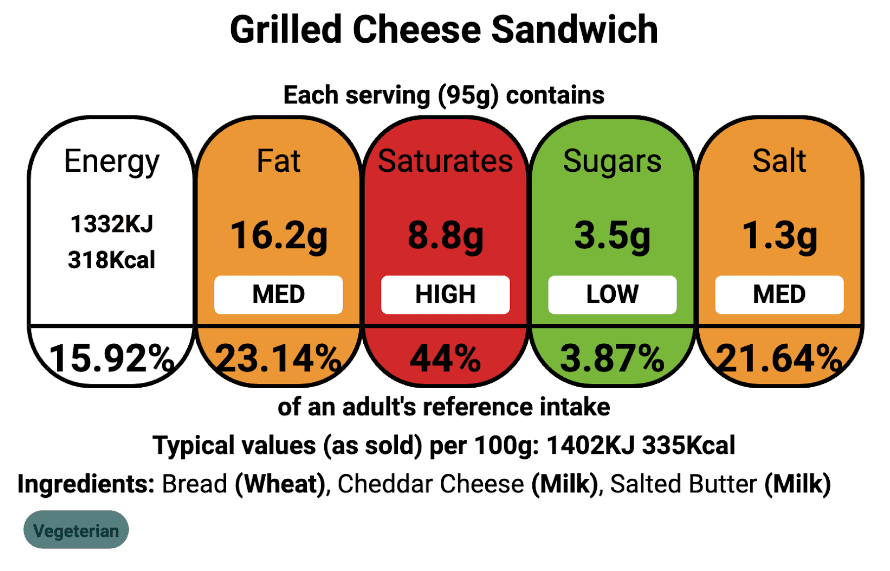
Format and Presentation of Front-of-Pack Labeling
Front-of-package food labels must follow specific guidelines to ensure the nutritional information is easily visible and comprehensible to consumers. The layout and design of these labels are important not only for maintaining consistency across product ranges and helping consumers make informed choices quickly.
Whether using a horizontal, vertical, or lozenge format, businesses must adhere to design principles that prioritize clarity and visibility.
Label Design and Layout
The design of food labels can vary depending on the available space and the nature of the product packaging:
- Horizontal Format: This is the preferred layout for most products, offering a clear, linear presentation of key nutrients and values across the front of the package.

- Vertical Format: Used when space is limited on narrower packages, allowing for an alternative display that maintains clarity.
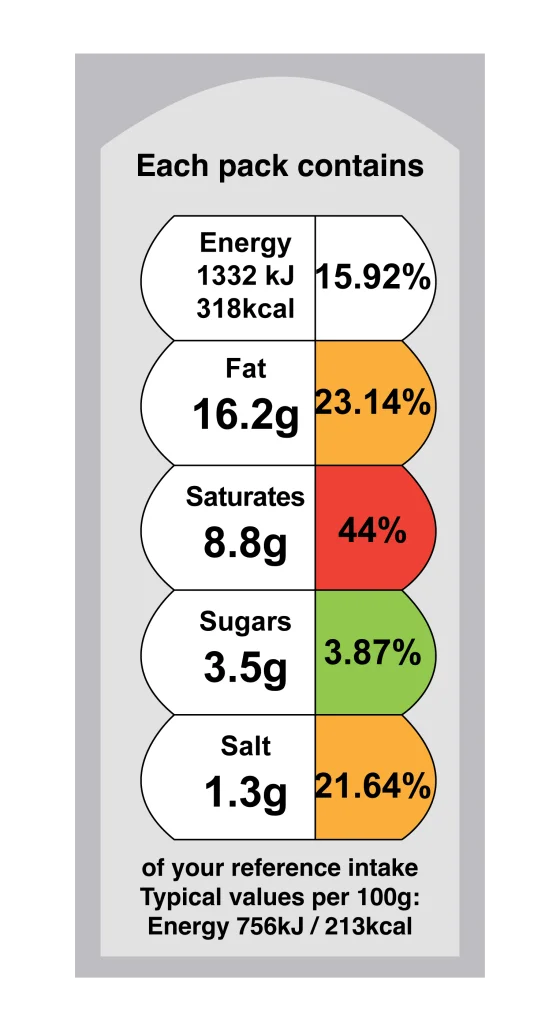
- Lozenge Style: In this format, each nutrient is separated into individual sections on the package, making it easier for consumers to quickly identify key nutritional components such as energy, fat, sugars, and salt.
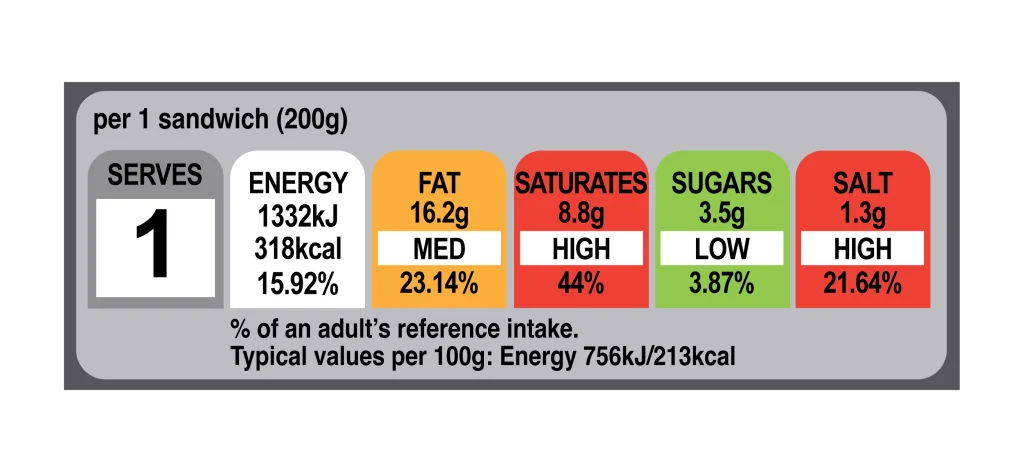
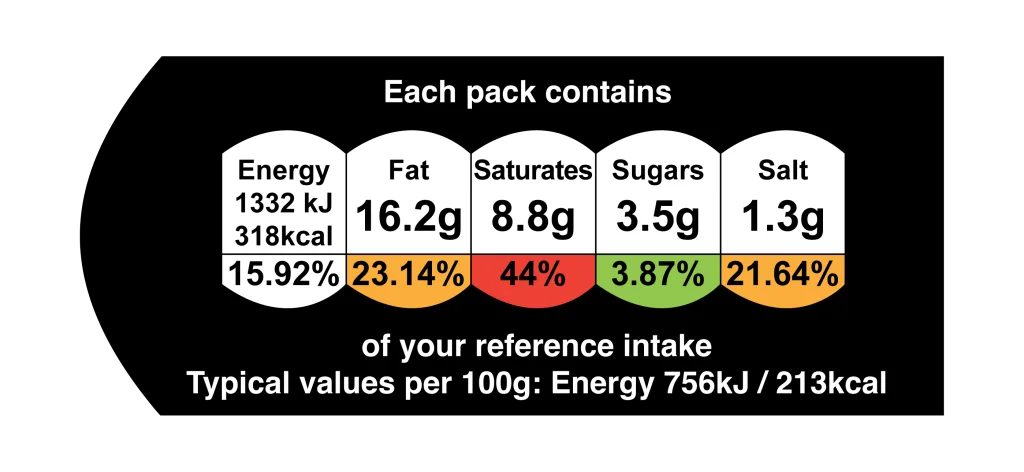
The label must be placed within the principal field of vision, which refers to the part of the packaging most likely to be seen by the consumer at first glance. This is typically where the product’s character or brand is identified. The food business manufacturer determines the primary field if there are several identical options.
For products that are typically consumed in equal portions, like dips, nutrition information may be provided per portion or per mix (e.g., one-third of the pack). If a product has multiple components, the full nutritional information should be displayed on the back, while the front should highlight the component with the highest nutrient values.
Color and Contrast Requirements
To aid in consumer understanding, FoP labels must follow specific color and contrast guidelines:
- Color Codes: The traffic light system—red, amber, and green—must use specific Pantone colors to ensure consistency across the food industry.
- Contrast: The text must stand out clearly against the background, allowing for easy reading. This is especially important for consumers with color vision deficiency, who may struggle to differentiate certain shades.
- Minimum Area: Each lozenge or section dedicated to a nutrient must have a minimum color area that covers at least one-third of the total lozenge, ensuring that the color-coding is prominent and easy to interpret.
Font Size and Legibility Rules
The legibility of the FoP label is critical to ensure that consumers can easily read and understand the information at a glance:
- Font Size: The minimum x-height for text on FoP labels is 1.2mm. This ensures that the information is large enough to be read without straining.
- Exceptions: For smaller packages where space is limited, exceptions may apply, but the text should remain as legible as possible.
- Placement: As with the label design, the text must be placed in the principal field of vision, ensuring it is not obstructed by other design elements on the packaging, such as promotional stickers or images.
Calculating and Displaying Portion Sizes on Food Packaging
Portion sizes play a critical role in helping consumers make informed decisions about their food intake. These sizes must be realistic and easy to understand, ensuring that consumers can quickly assess the nutritional quality of a given portion.
Front-of-package labeling requires portion information to be consistent with the back-of-pack declarations. For instance, if food packaging indicates a portion size of one slice on the back, the same must be reflected on the front label. Clear, concise descriptions such as “1 sandwich” or “¼ cake” make it easier for consumers to visualize the portion they’re consuming.
Under current regulations, FoP labels can display the energy content and key nutrients (fat, saturates, sugars, and salt) per portion or consumption unit. This is especially useful for foods with variable portion sizes like bread slices, where labeling by consumption unit provides practical clarity. Using standard portion sizes whenever possible ensures consistency across similar products, helping consumers compare different options and make healthier choices more efficiently.
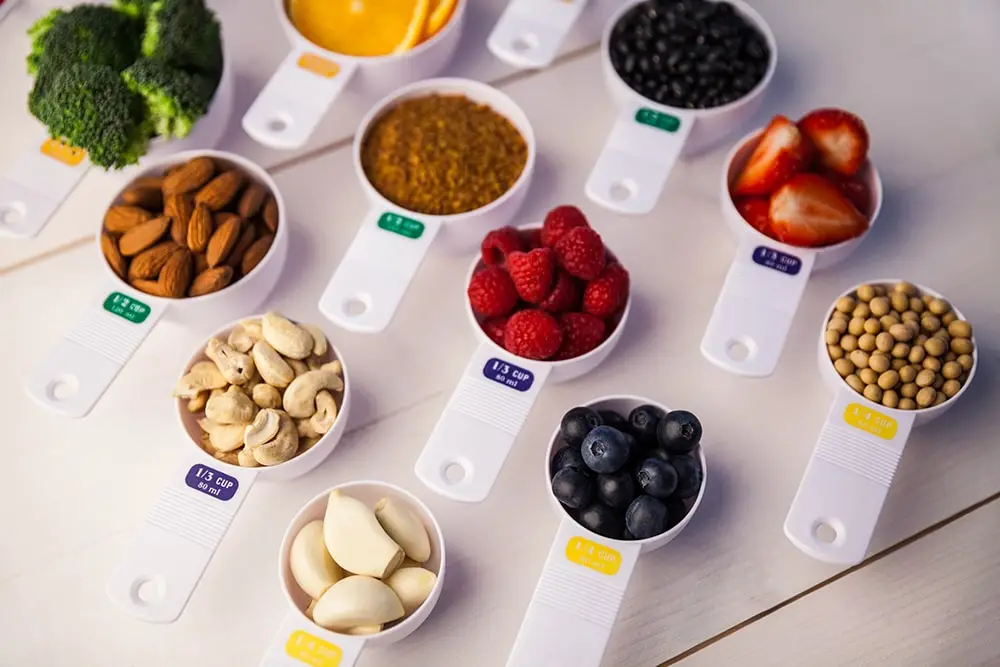
Special Considerations for Different Product Types
Front-of-Pack labeling must accommodate the specific characteristics of different food and drink products. Guidelines for nutrient thresholds are based on the product type, with additional considerations for portions that exceed typical serving amounts.
Foods
For solid foods, nutrition information is typically provided per 100g to help consumers compare products. Nutrient thresholds for fat, saturates, sugars, and salt are established to determine if the label should display a red, amber, or green color code. When portions exceed 100g, additional criteria may apply to account for the higher nutrient intake.
For example, a ready-made meal might need separate nutrient information for an individual portion compared to the per 100g data shown on the label. Larger portions may also require adjustments in the labeling to ensure that consumers are aware of how much they are consuming relative to recommended intake values.
Drinks
For beverages, nutritional information is based on a standard 100ml serving. However, special considerations come into play for drinks typically consumed in larger volumes, such as soft drinks or juices. If a portion exceeds 150ml, manufacturers may need to provide additional labeling information to reflect the larger serving size.
High-volume drinks, such as bottled beverages consumed in one sitting, may also need separate calculations to show the energy and nutrient content for the entire bottle. This ensures that consumers can accurately assess their intake when drinking the full portion, avoiding underestimating their consumption based on the per 100ml information alone.
Compliance with UK Food Industry Regulations Post-Brexit
Since Brexit, the UK has made adjustments to its front of package labeling regulations to reflect its departure from EU standards and regulations in other countries. While much of the existing food industry framework remains aligned with the pre-Brexit rules, there are some distinctions. The UK now has the flexibility to diverge from EU regulations, although many core elements, such as the traffic light system for nutrient thresholds, remain consistent.
One key difference is that the UK government can now set independent standards for labeling, which may evolve over time. It’s crucial for manufacturers, especially those exporting to both UK and EU markets, to stay informed on these developments. Compliance is essential not only for avoiding legal issues but also for ensuring that products are marketable in both domestic and international markets.
Smaller companies can stay updated on changes by consulting government resources like the Food Standards Agency (FSA) and other industry bodies, which provide regular updates on UK-specific regulations.
Benefits of Implementing FoP Nutrition Labels
Implementing consistent Front-of-Pack (FoP) nutrition labeling offers numerous benefits for both consumers and the food industry. When a large number of products display clear, standardized labels, it helps consumers make healthier food choices by easily understanding package labeling. This labeling system supports consumers in managing their energy intake and balancing their diet.
From a public health perspective, aligning with initiatives such as the UK’s “Eatwell Guide” promotes healthier diet habits across the population. A unified FoP system also has potential marketing advantages, particularly in health-conscious markets, where products with clear nutrition facts labels may gain a competitive edge.
By making small dietary improvements facilitated by FoP labels, the broader public health landscape can benefit, even potentially reducing healthcare costs over time.
Common Mistakes and How to Avoid Them
When implementing Front-of-Pack (FoP) nutrition facts labels, several common mistakes can lead to consumer confusion or non-compliance. These issues are:
- Misrepresenting nutritional information: Nutritional data can be misrepresented through inaccurate figures or incomplete details.
- Solution: Double-check the accuracy of all values to ensure transparency and trust.
- Incorrect use of color-coding: Misapplying the traffic light system can lead to misleading health claims.
- Solution: Follow the correct thresholds for each nutrient to ensure compliance with regulations.
- Inconsistency between FoP and back-of-pack information: Discrepancies between the front and back package labeling can lead to confusion and erode brand credibility.
- Solution: Ensure both labels are aligned and present the same information.
- Overlooking portion size implications: Unclear or unrealistic portion sizes can skew nutritional values, making the food product appear healthier than it is.
- Solution: Display portion sizes that are easy to understand and reflect actual consumption.
- Not updating labels when product formulations change: Outdated labels can lead to non-compliance with current regulations and mislead consumers.
- Solution: Regularly update labels whenever product formulations are modified to maintain compliance.
Accurate Front of Package Labeling with Food Label Maker
Food Label Maker’s intuitive software offers comprehensive features to help manufacturers create compliant and effective Front-of-Pack (FoP) nutrition labels. Their software automatically calculates accurate nutrition information data, %RIs, and other vital information. This ensures up-to-date and consistent representation of nutrition facts information based on the latest guidelines, and their constant updates can allow your labels to change as standards evolve post-Brexit.
The tool also facilitates easy updates when product formulations change, allowing for seamless label adjustments without hassle. Additionally, the software includes customizable design templates that ensure consistent and compliant layouts, saving time and effort in your business operations while adhering to legal requirements.
Conclusion
Front-of-Pack (FoP) labeling plays a crucial role in helping consumers make informed food choices by providing clear and accessible nutritional information. While FoP labeling is voluntary, it offers significant benefits for both consumers and manufacturers, supporting healthy eating patterns and aligning with public health goals. Staying updated with evolving regulations is vital to ensure compliance and maintain consumer trust.
Leveraging professional tools like Food Label Maker simplifies the process, ensuring that your labels are accurate, compliant, and easy to understand, ultimately enhancing your product’s credibility in the competitive food and beverage industry.


